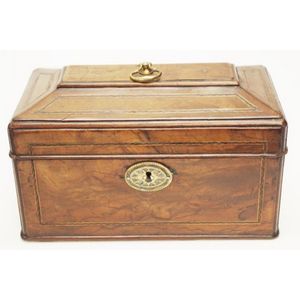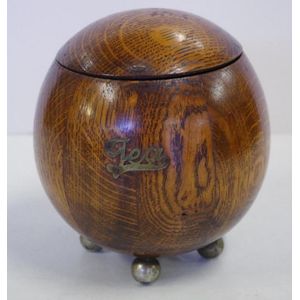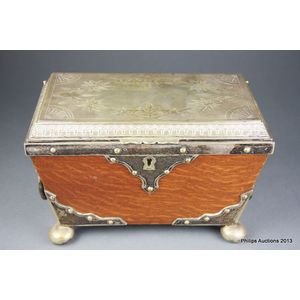
18th Century Georgian Tea Caddy with Inlay
A Georgian tea caddy, mahogany and oak with string inlay, 18th century, interior has been removed, a€‹5.91 in. high, 10.24 in. wide, 5.91 in. deep

George III Oak Tea Caddy with Tortoiseshell and Ivory Lids
A George III oak tea caddy, early 19th century, octagonal in form, with a domed lid opening to reveal two compartments with stained tortoiseshell and ivory lids, the interiors with remnant zinc lining, 4.92 in. high, 6.69 in. wide, 3.94 in. deep.

Regency Tea Caddy with Muckross Abbey Marquetry Inlay
A Regency Killarney ware arbutus wood and yew marquetry inlaid tea caddy, Irish, circa 1820, of sarcophagus form with a penwork panel of Muckross Abbey, 5.31 in. high, 10.24 in. wide, 5.12 in. deep. Note: The Muckross Abbey ruins, founded near Killarney…

Georgian Mahogany Tea Caddy with Loop Handle
Mid Georgian mahogany and oak tea caddy with loop handle to lid, 9.06 in. wide, 5.12 in. deep, 4.92 in. high

18th Century Walnut & Inlaid Tea Caddy with Axe Handle
Georgian 18th century walnut & chequer inlaid tea caddy with original axe handle to lid with three section oak interior.

Victorian Oak Tea Caddy with Gilt Handles
A Victorian oak tea caddy box late 19th century with two lidded compartments and gilt metal handles, height 6.30 in., width 9.45 in., depth 5.91 in.

Regency Oak Tea Caddy with Fruit Basket Handles
Rare Pollard oak Regency period tea caddy, of bomb sarcophagus shape, interior with lidded canisters and basket of fruit handles, c1825, 12.60 in. x 6.69 in., 7.48 in.

19th Century Queensland Silky Oak Tea Caddy
A tea caddy, silky oak, Queensland origin, 19th century 7.09 in. high, 8.27 in. wide, 5.12 in. deep

George III Mahogany Tea Caddy with Brass Handles
George III Cuban mahogany tea caddy, with quarter columns, triple oak interior divisions and original brass lid handles, c1770.

Georgian Mahogany Tea Caddy with Secret Drawer
Georgian Cuban mahogany tea caddy, with 3 sectioned oak interior, original rococo brass handles and escutcheon, a secret drawer is opened by opening the caddy and lifting up the outer right side, circa 1770, 10.63 in. wide, 5.51 in. deep, 6.30 in. high

Satinwood Tea Caddy with Secret Compartment
George III tea caddy, of various woods with satinwood sunburst and parquetry sides and back, oak interior with secret compartment and spoon tray

Regency Oak and Rosewood Tea Caddy, Circa 1810
A Regency oak and rosewood tea caddy, English, circa 1810, 7.09 in. high, 12.20 in. wide, 6.30 in. deep. Exhibited: Portobello Antiques, Auckland, 5 November 1990

English Oak Tea Caddy with Ceramic Liner and Feet
Vintage English oak tea caddy on 3 ball feet & with a ceramic liner

Carved Oak Tea Caddy with Two Divisions
A 19th century tea caddy. Carved oak, with two divisions. 7.09 in. high.

Rare Australian Folk Art Tea Caddy Box, 1929
A rare Australian folk art specimen tea caddy box, c.1929, made at the Wertheim piano factory. Burnley Melbourne, with inner label detailing some of the timbers used, including Queensland maple, silky oak, mountain ash, jarrah and swan bone. The top panel

Victorian Oak Tea Caddy with Silver Plate Mounts
A late Victorian silver plate mounted oak tea caddy, late 19th century, of sarcophagus form with a hinged top enclosing two compartments with covers, the metal cover engraved with bamboo and foliate designs, the body with decoratively shaped mounts through